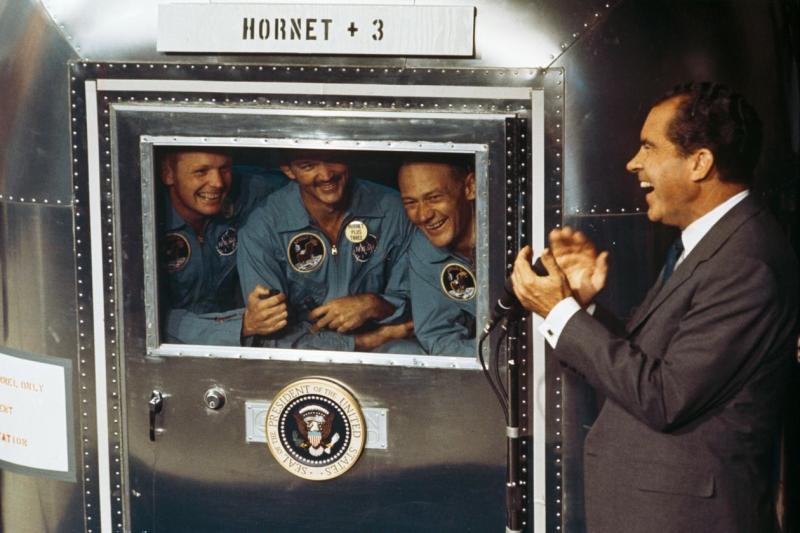'Operation Moonglow' Review: The Rockets' Red Scare
By: Edward Kosner (WSJ)



Around 1 a.m. Moscow time on Oct. 5, 1957, receiving stations around the globe began picking up demure new radio signals from space—“beep-beep-beep-beep-beep-beep-beep . . .” They came from a shiny silver sphere the size of a basketball that was orbiting the Earth every 90 minutes, and they heralded the first step in the epic Cold War race for space between America and the Soviet Union.
More than six decades later, the saga of Sputnik 1 seems as quaint as those flickery old movies of the Wright brothers’ first flight over the dunes at Kitty Hawk, N.C. But at the time, the first Soviet space triumph nearly convulsed American politics as an ebullient Nikita Khrushchev proclaimed the superiority of Soviet technology. The U.S. responded, of course. Hardly a dozen years later, Apollo astronauts Neil Armstrong and Buzz Aldrin walked on the moon, and barely two decades after that the Soviet Union imploded.
Now, in “Operation Moonglow,” Teasel Muir-Harmony retells the story from a narrow, new perspective—how the U.S. used space exploration as a propaganda weapon in the Cold War competition for international prestige and influence. The result is a conscientiously researched account that may be a long haul for general readers. After all, it’s no revelation that John Kennedy, Lyndon Johnson, Richard Nixon, Henry Kissinger, John Foster Dulles and his brother Allen (head of the CIA) practiced diplomatic lunacy with great flair.
The author tracks the early space race like a sports event or a checkers game: First Sputnik 1, then Sputnik 2 (which carried the doomed mutt Laika in her overheating capsule). America’s first Vanguard rocket exploded on the pad. “Oh, What a Flopnik!” headlined a British paper. Finally, the U.S. got the Explorer 1 satellite off the ground in early 1958 and fired Ham the chimp down range in January 1961. But in April, Soviet cosmonaut Yuri Gagarin became the first human to orbit the Earth—a world-wide sensation. After the bad press of the Bay of Pigs that spring, and goaded by Johnson and his scientific advisers, Kennedy committed to the multi-billion-dollar Project Apollo to beat theRussians to the moon by 1970.
That was years away. In May 1961, America managed to swap Alan Shepard in for Ham for a 15-minute suborbital flight, and then, in February 1962, John Glenn became a national hero when his Friendship 7 spacecraft circled the Earth three times and splashed down safely in the Atlantic.
Beginning with Shepard’s flight, Ms. Muir-Harmony writes, the U.S. embarked on an exhaustive mission to win the world’s hearts and minds by promoting—scolds would say exploiting—the astronauts and their spacecraft as symbols not only of America’s technological superiority but also its commitment to sharing its democratic values with “all mankind.” Much of this amounted to what the historian Daniel J. Boorstin defined at the time in other contexts as “pseudo-events”—press conferences and other staged episodes designed to generate publicity and goodwill.
After each successful Mercury and Gemini space exploit, the all-American astronauts, often accompanied by their perfect wives, went on tour, especially to uncommitted “Third World” countries. Huge crowds turned out in Europe, too. The Voice of America broadcast the missions live around the world; telecasts, movies, exhibits, brochures and lectures filled out the campaign. Most of this was organized by the lavishly funded U.S. Information Agency, headed by the chain-smoking news wizard Edward R. Murrow. The Russians, too, sent their space heroes on the publicity-campaign trail, but in contrast to the Americans, kept their spacecraft mostly under wraps and revealed no technical secrets.
To tell her story, Ms. Muir-Harmony, a curator at the Smithsonian’s National Air and Space Museum, has mined the information agency’s archives so thoroughly that she buries the reader in repetitious detail. Her book is stuffed with crowd estimates at exhibits, poll results from obscure outposts like Madagascar, and chirpy dispatches from far-flung U.S.I.A. staffers. Still, she has to observe, “it is worth noting that the extent to which the idea of US progress was etched upon the world’s consciousness is impossible to measure.”
The Cold War space race eventually energized American politicians. Dwight Eisenhower thought space exploration had no military value. Sen. John Kennedy initially dismissed it as a waste of money. But Lyndon Johnson, first as Senate majority leader, then as Kennedy’s vice president and successor, pushed the Apollo program over the goal line. In the end it cost nearly $300 billion in today’s money—18 times more than building the Panama Canal, five times more than the Manhattan Project that created the atom bomb, more than Eisenhower’s epic interstate highway system.
Richard Nixon was the chief promoter and beneficiary of the post-moon-landing PR blitz known as Operation Moonglow. In August 1969, he feted the triumphant Apollo astronauts, sped out on an eight-country foreign junket to pressure the North Vietnamese into a peace deal and to advance his opening to China, then sent the Apollo crew on Giantstep, a 38-day tour of 24 countries, always stressing the one-world altruism of the U.S. space program. But at the end of her book, the author has to admit that much of that afterglow has evanesced and the world seems as fractious as ever.
So the irony—unremarked by Ms. Muir-Harmony—is that the exploration of space, one of mankind’s premier achievements, owes its impetus less to Promethean scientific ambition than to the competition between capitalism and communism in the middle of the 20th century. And the provisional victory of capitalism in that struggle owes less to winning the space race than to fundamental contradictions—as Marx would say—of the socialist regime he inspired.
Mr. Kosner is the former editor of Newsweek, New York, Esquire and the New York Daily News.




